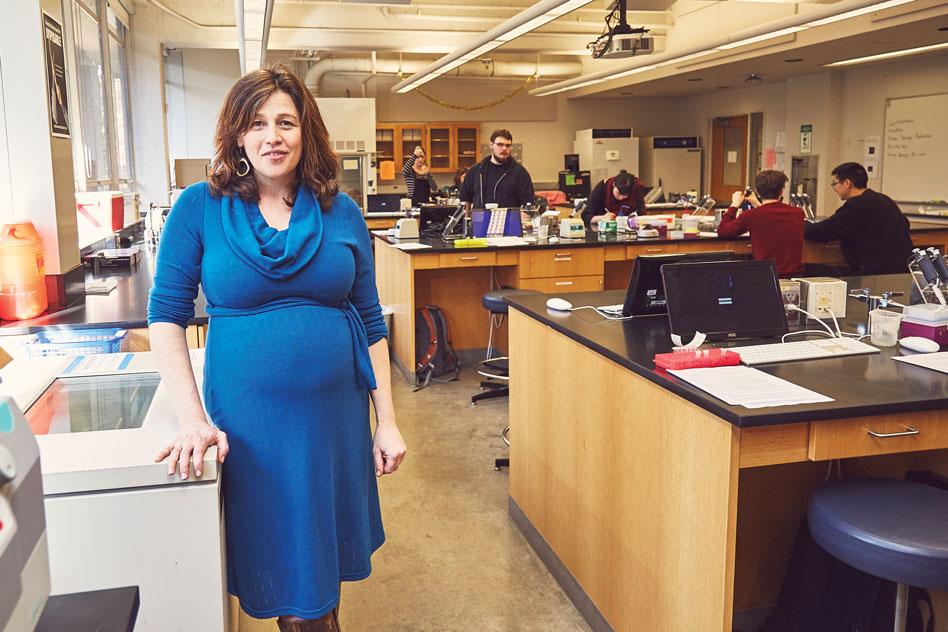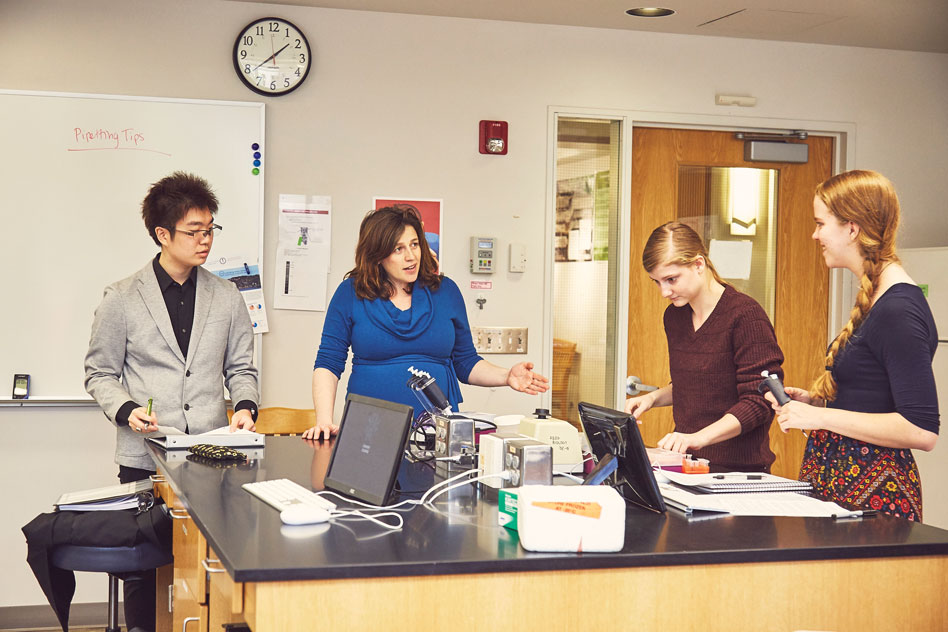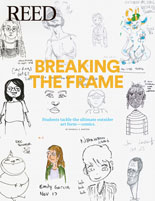
IRIS login | Reed College home Volume 96, No. 1: March 2017
Codebreaker

Prof. Sarah Schaack teaches lab techniques to students in her Genes, Genetics & Genomes course. She is expecting a baby in May! Photo by Matt D'Annunzio
Prof. Sarah Schaack [biology] cracks the secrets of rogue DNA
By Katie Pelletier ’03
On June 24, 2000, President Bill Clinton and British Prime Minister Tony Blair made a dramatic joint announcement. After decades of intense effort, scientists around the world had acheived a remarkable breakthrough: the sequencing of the human genome.
Prof. Sarah Schaack was a grad student when she heard the news—and the many unexpected developments that would soon follow.
First of all, after the helical skein was unfurled, and the roughly 3.3 billion nucleotides accounted for, the actual number of genes in the human genome would prove to be surprisingly few. Scientists had guessed that we would boast around 100,000 genes. Instead, the human genome consists of a mere 20,500 genes, similar to the earthworm, but only half as many as rice (40,000). In fact, genes comprise less than 2% of our genetic material.
So what is the other 98%? Scientists refer to it as “junk,” and for many years it was overlooked. But it was this junk DNA that would capture Schaack’s attention.
![]()

Photo by Matt D'Annunzio
On a rainy afternoon in December, I find Prof. Schaack in her office in the biology building sitting among piles of papers and stacks of lab notebooks. She wears a festive holiday-light necklace; through the door, you can hear the muffled clink of students washing glassware in the lab.
Schaack came to Reed in 2011. When not in the classroom or lab, she can be found taking students on field trips to collect specimens like speckled rattlesnakes in the desert or hosting jam sessions in her living room. She is committed to community outreach and runs a program teaching bioinformatics and genomics to young scientists in East Africa.
“I like provoking people to think differently about things,” she says. “I like sharing very recent discoveries instead of having it be that people are only exposed to things that are fossilized in text books.”
It’s a busy time of year. There are thesis chapters to read, lab notebooks to grade, and lectures to prepare. But Schaack is happy to talk about her specialty: a kind of DNA known as transposable elements (TEs).
“They are a topic in science that has lots of the elements of a good story,” she says. “They’re surprising, they’re underestimated, they are underappreciated, and they’re wacky.”
TEs are basically asymptomatic viruses that have invaded our genome, recently or eons ago, and can still operate as both protagonists and antagonists, influencing function and health. TEs, in other words, are tricksters: they’ve hitched a ride on our genome, and they can jump around within that genome as well as transfer to the genomes of other species. They can be small or large segments of DNA, and they partake in an exciting coevolutionary dynamic with their hosts. They’re referred to as “selfish DNA” because they operate to ensure their own, not their host’s, survival. And, importantly, all that jumping around can give rise to mutations in their host, usually neutral to deleterious, but sometimes remarkable and dramatic, even beneficial. “Those are the fairy tales of the transposable element world,” she says.
TEs were first discovered by biologist Barbara McClintock at Cold Spring Harbor Lab in the late 1940s, but it took another four decades for the importance of her findings to be recognized—a lag often attributed to the difficulties faced by women in biology.
It turns out that most of our DNA is comprised of TEs. Modern sequencing technology has made great advances in our understanding, but still, comparatively few labs study TEs, and they remain enigmatic.
Schaack researches the rates of movement of TEs and their large-scale accumulation in the genome. She looks at organisms like the speckled rattlesnake, waterfleas, Tasmanian devils, bats, and crop pests to better understand mutations, especially those that arise from TE movement.
“There’s nothing else in biology that I would rather study than transposable elements. In fact if I couldn’t study TEs, I don’t know if I would be a biologist. I really love this question, this set of questions,” she says.
She almost didn’t study this set of questions. In 1999, she enrolled in a PhD program to study tropical ecology at the University of Florida. There, she came upon something new. “I had a terrible case of genetics envy brewing, and so I started a journal club on evolutionary genetics with a friend of mine,” she says. The journal club would meet once a week and discuss a selection of scientific papers. The members were mostly professors, and the club had one unofficial rule—you had to bring a paper that was outside your comfort zone. “If the professors brought a paper that they didn’t really know, there was no intimidation in talking about it, because we all were clueless about it.”
One day, a biologist she admired brought a paper on the recently sequenced pine genome, the biggest genome to be sequenced at that point. “It turns out that most of what’s in pine is transposable elements. And I had never heard of transposable elements before,” she says.
Schaack was hooked. She realized she was in the the wrong PhD program, and so she made the risky decision to reapply to graduate school and change the entire trajectory of her career.
“You can see why—” she says, then pauses. “I guess maybe I haven’t said this in words, but that’s why I’m pretty excited about sharing new stuff that’s on the edge of my knowledge with students, because that’s what someone did with me. And it had a big effect.”
The mentors who backed her along the way also had a big effect. As a first-generation student at Earlham, a small liberal arts school in Indiana, she found herself a bit lost at first. During orientation week of her freshman year, her advisor asked her about her plans for graduate school. “I was 17 years old, I was the first person in my family to go to college, and I had zero dollars,” she says. “I said, ‘I don’t know what that is.’ And he said, ‘Well never mind then, it doesn’t matter. You can take whatever you want.’” That was all the guidance she got until she was fortuitously reassigned to a new advisor, who took a different approach.
“He really asked me, ‘What do you want to do?’ And I still didn’t know. But the whole tenor of the conversation was much more thought-provoking and exploratory for me.” He helped her to hone in on her interest in biology and later suggested she apply for a position at the Kellogg Biological Station when she graduated. This guidance was life-changing.
Other mentors would also show her paths and opportunities that she otherwise wouldn’t have known existed, and she would seize them. “I benefitted so much from that good mentorship and the good advice that people gave me without me even seeking it, so I try to be proactive about offering that kind of good environment to the Reed students that I mentor,” she says. “Maybe not being the easiest person in the world myself to mentor has made me better at mentoring other folks. If I had been really well-behaved, and well-prepared, and never made a mistake, I might not have learned as many lessons about what good mentorship could do.”
In 2016, she won an award from the Murdock Charitable Trust recognizing the extraordinary way she involves undergraduates in her research. In her lab this semester, students will work with her to advance scientific understanding of TEs, analyzing rates of TE movement in Drosophila and Daphnia—research made possible by a $1 million grant from the National Science Foundation.
Former thesis student Michael Song ’15, a PhD candidate studying fern evolution at UC Berkeley, notes that Schaack was “the single most influential person” in his time at Reed.
“I think what distinguishes her as a mentor is the trust she puts in you to really figure things out,” he says. “You can have no background in her field but you’ll come out of her lab essentially a pro. She holds students to high standards and that’s important whether you’re going to grad school or anything really.”
Jolie Kaner ’15, who coauthored a paper with Schaack on Ebola based on her senior thesis, notes fondly that Schaack dove into unknown territory, outside her field, on this project because it was important to Jolie.
Schaack’s willingness to tackle new subjects with students is no small thing. Since 2011 she has mentored over 50 individual Reed student research experiences and published 8 papers with students in peer-reviewed journals.
Whether investigating transposable elements, mutation, or advising a student making important findings about Ebola, Schaack's curiosity and knack for provoking interest in overlooked areas is leading to new discoveries—whose implications have yet to be mapped out.

LATEST COMMENTS
steve-jobs-1976 I knew Steve Jobs when he was on the second floor of Quincy. (Fall...
Utnapishtim - 2 weeks ago
Prof. Mason Drukman [political science 1964–70] This is gold, pure gold. God bless, Prof. Drukman.
puredog - 1 month ago
virginia-davis-1965 Such a good friend & compatriot in the day of Satyricon...
czarchasm - 4 months ago
John Peara Baba 1990 John died of a broken heart from losing his mom and then his...
kodachrome - 7 months ago
Carol Sawyer 1962 Who wrote this obit? I'm writing something about Carol Sawyer...
MsLaurie Pepper - 8 months ago
William W. Wissman MAT 1969 ...and THREE sisters. Sabra, the oldest, Mary, the middle, and...
riclf - 10 months ago